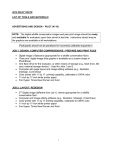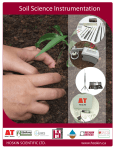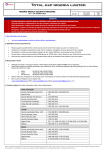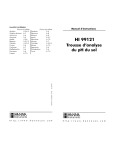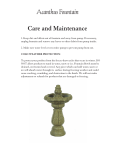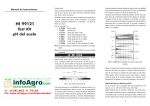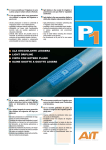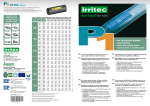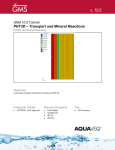Download HI 99121 Soil pH Test Kit
Transcript
Instruction Manual HI 99121 Soil pH Test Kit SPECIFICATIONS w w w . h a n n a i n s t . c o m PRELIMINARY EXAMINATION Dear Customer, Thank you for choosing a HANNA instruments® product. Please read this instruction manual carefully before using the instrument. This manual will provide you with the necessary information for correct use of the instrument, as well as a more precise idea of its versatility. If you need additional technical information, do not hesitate to email us at [email protected]. This instrument is in compliance with the directives. Remove the test kit from the packing material and examine it carefully to make sure that no damage has occurred during shipping. If there is any damage, immediately notify your dealer. Each kit includes: • HI 99121 portable pH meter • HI 1292D pH electrode • pH 4.01 & pH 7.01 buffer solutions (20 mL each) • HI 700663 cleaning solution for inorganic soil deposits • HI 700664 cleaning solution for organic soil deposits • HI 7051M soil preparation solution • HI 721319 ground auger • 3 x 1.5V AA alkaline batteries • instruction manual • rugged carrying case Note: Save all packing material until you are sure that the instrument functions correctly. All defective items must be returned in the original packing with the supplied accessories. TABLE OF CONTENTS WARRANTY PRELIMINARY EXAMINATION ........................................... 3 WARRANTY ......................................................................... 3 SOIL pH ............................................................................... 4 ORGANIC SUBSTRATE ...................................................... 8 IRRIGATION WATER ........................................................... 8 NUTRIENT SOLUTION ........................................................ 8 pH METER SPECIFICATIONS ........................................... 11 OPERATING THE pH METER ........................................... 12 pH MEASUREMENT & CALIBRATION .............................. 13 METER SETUP ................................................................... 14 ELECTRODE CLEANING ...................................................15 BATTERY REPLACEMENT ................................................ 15 All Hanna Instruments meters are warranted for two years against defects in workmanship and materials when used for their intended purpose and maintained according to instructions. The probes are warranted for a period of six months. This warranty is limited to repair or replacement free of charge. Damage due to accidents, misuse, tampering or lack of prescribed maintenance are not covered. If service is required, contact the dealer from whom you purchased the instrument. If under warranty, report the model number, date of purchase, serial number and the nature of the problem. First obtain a Returned Goods Authorization number from the Customer Service department, then return the instrument with the Authorization number included along with shipment costs prepaid. If the repair is not covered by the warranty, you will be notified of the charges. When shipping any instrument, make sure it is properly packaged for complete protection. 2 3 SOIL p H pH is the measure of the hydrogen ion concentration [H+]. Soil can be acid, neutral or alkaline, according to its pH value. Fig. 1 shows the relationship between the scale of pH and types of soil. Most plants prefer a pH range from 5.5 to 7.5; but some species prefer more acid or alkaline soils. Nevertheless, every plant requires a particular range of pH, for optimum growth. Fig. 1. Types of soil according to the pH value pH strongly influences the availability of nutrients and the presence of microorganisms and plants in the soil. For example, fungi prefer acidic conditions whereas most bacteria, especially those supplying nutrients to the plants, have a preference for moderately acidic or slightly alkaline soils. In fact, in strongly acidic conditions, nitrogen fixing and the mineralization of vegetable residual is reduced. Plants absorb the nutrients dissolved in the soil water and the nutrient solubility depends largely on the pH value. Hence, the availability of elements is different at different pH levels (Fig.2). Each plant needs elements in different quantities and this is the reason why each plant requires a particular range of pH to optimize its growth. For example, iron, copper and manganese are not soluble in an alkaline environment. This means that plants needing these elements should theoretically be in an acidic type of soil. Nitrogen, phosphorus, potassium and sulfur, on the other hand, are readily available in a pH range close to neutrality. Furthermore, abnormal pH values, increase the concentration of toxic elements for plants. For example, in acid conditions, there can be an excess of aluminum ions in such quantities that the plant can not tolerate. Negative effects on chemical and physical structure are also present when pH values are too far from neutral conditions (break up of aggregates, a less permeable and more compact soil). Management of the soil in relation to the pH value Once the pH value is known, it is advisable to choose crops that are suitable for this range (e.g. in an acid soil, cultivate rice, potato, strawberry). Add fertilizers that do not increase acidity (for example urea, calcium nitrate, ammonium nitrate and superphosphate) or lower alkalinity (e.g. ammonium sulfate). It is recommended that a cost evaluation is made prior to commencement of the soil pH modification. Corrective substances can be added to modify the soil pH, however, the effects are generally slow and not persistent. For example, by adding lime, the effects in clay soil can last for as long as 10 years, but only 2-3 years in a sandy soil. For an acid soil, we can use substances such as lime, dolomitic, limestone and marl, according to the nature of the soil (Tab.1). Soil Ameliorants Clay soil Silty soil Sandy soil CaO 30-50 20-30 10-20 Ca(OH)2 39-66 26-39 13-26 CaMg(CO3)2 49-82 33-49 16-33 Ca CO3 54-90 36-54 18-36 Tab.1. Quantity (q/ha) of pure compound necessary to increase 1 unit of pH Fig. 2. Solubility of the elements according to varying pH 4 5 High pH levels can depend on different elements, hence, there are different methods for its correction. - Soils rich with limestone: Add organic matter (this is due to the fact that non-organic ameliorants such as sulfur and sulfuric acid might not make economic sense due to the large quantities needed). - Alkaline-saline soils: Alkalinity is due to the presence of salts (in particular a high concentration of sodium can be harmful). Irrigation washes away salts, hence, an appropriate use of irrigation can provide positive results (drop-irrigation being the most recommended). If alkalinity is caused by sodium, it is recommended to add substances such as gypsum (calcium sulfate), sulfur or other sulfuric compounds (Tab.2). Also in this case, a cost evaluation is necessary. Soil ameliorants (pure compounds) Quantity (kg) Calcium chloride: CaCl2 · 2H2O 85 Sulfuric acid: H2SO4 57 Sulfur: S 19 Iron sulfate: Fe2 (SO4)3 · 7H2O 162 129 Aluminum sulfate: Al2 (SO4)3 Tab.2. Quantities provide the same result as 100 kg of gypsum Procedure for direct ground measurement 1) Dig, discarding 5 cm of topsoil 2) Perforate the soil (with HI 721319 soil drill) to a depth of about 20 cm or more 3) If the soil is dry, moisten it with a small amount of distilled water 4) Wash the electrode with tap water (not distilled) 5) Insert the electrode pushing it slightly into the soil to ensure proper contact 6) Observe the measurement 7) Wash the electrode with tap water (not distilled) and (using a finger) gently remove any soil remaining on the electrode (avoid using a rag or cloth) 8) Repeat the procedure in different locations in the field 9) Consider the average of the measured data 6 For best result, it is advisable to measure the pH of a soil solution, using a sample of soil and soil preparation solution HI 7051; it is better to use this procedure if you have to test a stony field in which you risk damaging the electrode. Procedure for the measurement of soil solution (1:2,5) A) Sampling 1) Extracting Soil Sample. Take 1 sample per 1000 m2 (0.25 acre) of homogeneous area. Even for small areas, 2 samples are recommended (the more the samples, the better the end-results, because the result is more representative). 2) Avoid extracting samples from soil presenting obvious anomalies and consider them separately. 3) Sample quantity: Take the same quantity of soil for each sample. For example, use bags with similar dimensions (1 bag per sample). 4) Depth of extraction: General: dig and discard 5 cm (2") of topsoil. Herbaceous crops: from 20 to 40 cm of depth (8" to 16"). Orchards: from 20 to 60 cm of depth (8" to 24'’). 5) Spread the soil samples on the pages of a newspaper and let the soil dry in a shady place or put it in an oven at 40°C. 6) Crumble the dried soil and mix all the samples together to obtain a homogeneous mixture, discarding stones and vegetable residues. 7) From this mixture, take the soil sample for analysis. B) Soil solution preparation and measurement 1) Sift the soil at 2 mm. 2) Weigh 10 g of soil and put it in 25 ml of soil preparation solution HI 7051 (use the apposite beaker) or 20 g of soil per 50 ml of soil preparation solution HI 7051. 3) Mix for 30 seconds. 4) Wait for about 5 minutes. 5) Mix again and measure the pH of the solution. 7 ORGANIC SUBSTRATE pH measurements of organic substrates is important in greenhouses and nursery growing pots. pH should be checked at the outset to make sure that the pH of the substrate bought is that desired (pH can change if too much time elapses from the date of packaging to the moment of utilization). A) Direct measurement in pot If the substrate is dry, add a little distilled water. Insert the electrode into the soil and take measurement. B) Measurement of the organic substrate solution (1:2) Let the substrate dry and discard the coarse vegetable residues and pebbles. Prepare a solution composed of 1 part of mould and 2 parts of HI 7051 solution (for example: fill the beaker with the substrate up to 50 ml, press it gently, empty the content in another container and add 100 ml of HI 7051 solution). Mix for 30 seconds and then wait for 5 minutes. Mix again and measure the pH of the solution. IRRIGATION WATER The quality of irrigation water is a very important factor. If the pH value is very far from pH 7, it is possible that other anomalies are present. Ranges for evaluation of water quality: - 6 to 8.5 pH: good, it can be utilized without problems. - 5 to 6 pH or 8.5 to 9 pH: sufficient, sensible crops could have problems. - 4 to 5 pH or 9 to 10 pH: scarce, use it carefully, avoid wetting the vegetation. - pH<4 or pH>10: very scarce, there are other anomalies that have to be identified via chemical analysis. NUTRIENT SOLUTION A rational fertilization is needed for optimum plants growth in greenhouses. The pH value of the nutrient solution (water + fertilizer) has to meet the plants need. If a fertirrigation system with automatic pH control is used, ensure that it is functioning properly. Check the pH of the irrigation solution as well as any recycled solution. 8 ORCHARD PLANTS Preferred pH Range Apple Apricot Cherry Grapefruit Grapevine Lemon Nectarine 5-6.5 6-7 6-7.5 6-7.5 6-7 6-7 6-7.5 Preferred pH Range Orange Peach Pear Plum Pomegranate Walnut 5-7 6-7.5 6-7.5 6-7.5 5.5-6.5 6-8 VEGETABLES AND HERBACEOUS CULTIVATIONS Preferred pH Range Artichoke Asparagus Barley Bean Brussels Sprout Early carrot Late carrot Cucumber Egg Plant Lettuce Maize Melon Oat Onion Pea 6.5-7.5 6-8 6-7 6-7.5 6-7.5 5.5-7 5.5-7 5.5-7.5 5.5-7 6-7 6-7.5 5.5-6.5 6-7 6-7 6-7.5 Preferred pH Range Pepper Early Potato Late Potato Sweet Potato Pumpkin Rice Soybean Spinach Strawberry String Sugar beet Sunflower Tomato Watermelon Wheat 6-7 4.5-6 4.5-6 5.5-6 5.5-7.5 5-6.5 5.5-6.5 6-7.5 5-7.5 6-7.5 6-7 6-7.5 5.5-6.5 5.5-6.5 6-7 LAWN Preferred pH Range Lawn 6-7.5 GARDEN PLANTS AND FLOWERS Preferred pH Range Acacia Acanthus Amaranth Bougainvillea Dahlia Erica Euphorbia Fuchsia Gentian Gladiolus Hellebore Hyacinth Iris Juniper 6-8 6-7 6-6.5 5.5-7.5 6-7.5 4.5-6 6-7 5.5-7.5 5-7.5 6-7 6-7.5 6.5-7.5 5-6.5 5-6.5 Preferred pH Range Ligustrum Magnolia Narcissus Oleander Paulownia Portulaca Primula Rhododendron Roses Sedum Sunflower Tulip Viola 9 5-7.5 5-6 6-8,5 6-7.5 6-8 5.5-7.5 6-7.5 4.5-6 5.5-7 6-7.5 5-7 6-7 5.5-6.5 HOUSE PLANTS Preferred pH Range Abutilon African violet Anthurium Araucaria Azalea Begonia Camellia Croton Cyclamen Dieffenbachia Dracaena Freesia 5.5-6.5 6-7 5-6 5-6 4.5-6 5.5-7.5 4.5-5.5 5-6 6-7 5-6 5-6 6-7.5 Preferred pH Range Gardenia Geranium Hibiscus Jasmine Kalanchoe Mimosa Orchid Palms Peperomia Philodendron Yucca pH METER SPECIFICATIONS 5-6 6-8 6-8 5.5-7 6-7.5 5-7 4.5-5.5 6-7.5 5-6 5-6 6-7.5 Range (*) Resolution Accuracy (@20°C/68°F) -2.00 to 16.00 pH -5.0 to 105.0°C / 23.0 to 221.0°F 0.01 pH / 0.1°C / 0.1°F ±0.02 pH ±0.5°C up to 60°C; ±1°C outside ±1°F up to 140°F; ±2°F outside Temperature Compensation Automatic pH Calibration Automatic, 1 or 2 point with 2 sets of memorized buffers Probe (included) HI 1292D pH/temperature probe Battery Type / Life 3 x 1.5V AA (IEC LR6) / approx. 1500 hours Auto-off After 8 minutes of non-use Environment 0 to 50°C (32 to 122°F); RH 100% Dimensions 150 x 80 x 36 mm (5.9 x 3.2 x 1.4”) Weight 210 g (7.4 oz.) (*) The temperature range is limited to 80°C (176°F) if using the HI1292D probe. To clean the meter, use water only. 10 11 OPERATING THE pH METER To connect the probe With the meter turned off, connect the HI 1292D probe to the DIN socket on the top of the meter by aligning the pins and pushing in the plug. Tighten the nut to ensure a good connection. Remove the protective cap from the probe before taking any measurements. To turn the meter ON and check the battery status Press the ON/OFF/MODE button until the display lights up. At start-up, all the LCD segments are displayed for 1 second, then the percent indication of the remaining battery life is shown for another second (E.g. % 100 BATT). The meter then enters the normal measuring mode. Note: If the display needs to be checked, keep the ON button pressed while turning the meter on. The meter will display all segments as long as the button is pressed. To freeze the display While in measurement mode, press the SET/HOLD button, HOLD appears on the secondary display and the reading will be frozen on the LCD (E.g. pH 5.73 HOLD). Press any button to return to normal mode. To turn the meter OFF While in normal measurement mode, press the ON/OFF/MODE button. OFF will appear on the secondary display. Release the button. Note: The meter is provided with an acoustic signal feature, which can be disabled using the switch located in the battery compartment. Note: When the meter detects the absence of a temperature probe at its input, the Automatic Temperature Compensation is turned off, and the meter uses a default value of 25°C (77°F) for the temperature measurement and compensation. In this condition, the secondary LCD shows 25.0°C (77.0°F) blinking. When a probe is connected, the meter automatically returns to the ATC mode, the ATC tag is turned on, and the temperature is shown on the secondary display. 12 pH MEASUREMENT & CALIBRATION • Make sure the meter has been calibrated before use. • If the probe is dry, soak it in HI 70300 storage solution for one hour to reactivate it. • Place the tip of the probe into the sample to be tested, stir briefly and wait until the stability symbol on the LCD is turned off. • The LCD shows the pH value (automatically compensated for temperature) on the primary LCD, while the secondary LCD shows the temperature of the solution. • If measurements are taken in different samples successively, rinse the probe tip thoroughly to avoid contaminations. After cleaning, rinse the probe tip with some of the sample to be measured. pH calibration For better accuracy, a frequent electrode cleaning (see also pag. 15) and meter calibration is recommended. In addition, the instrument must be recalibrated whenever: a) The pH electrode is replaced. b) After testing aggressive chemicals. c) Where high accuracy is required. d) At least once a month. • From normal mode, press & hold ON/OFF/MODE until OFF on the secondary display is replaced by CAL. Release the button. • The LCD enters the calibration mode, displaying “pH 7.01 USE” (or “pH 6.86 USE” if the NIST buffer set was selected). After 1 second the meter activates the automatic buffer recognition feature. If a valid buffer is detected, then its value is shown on the primary display, and REC appears on the secondary LCD. If no valid buffer is detected, the meter keeps the USE indication active for 12 seconds, and then replaces it with WRNG, indicating that the sample being measured is not a valid buffer. • For a single-point calibration with buffers pH 4.01, 9.18 or 10.01, the meter automatically accepts the calibration when the reading is stable; the meter will show on the primary display the accepted buffer, with the message “OK 1” on the secondary display, and an audible signal is produced. After 1 second the meter automatically returns to the normal measuring mode. If a single-point calibration with buffers pH 7.01 or 6.86 is desired, then after the calibration point has been accepted press the ON/OFF/MODE button in order to return to the normal measuring mode. After the button is pressed, the meter shows 13 "7.01" (or "6.86") - "OK 1", and an audible signal is produced. After 1 second, the meter automatically returns to the normal measuring mode. Note: It is always recommended to carry out a two-point calibration for better accuracy. • For a two-point calibration, place the probe in pH 7.01 (or pH 6.86) buffer. After the calibration point has been accepted, the “pH 4.01 USE” message appears. The message is held for 12 seconds, unless a valid buffer is recognized. If no valid buffer is recognized, then the WRNG message is shown. If a valid buffer (pH 4.01, pH 10.01 or pH 9.18) is detected, then the meter completes the calibration procedure. When the buffer is accepted, the LCD shows the accepted value with the “OK 2” message on the secondary display. The meter then returns to the normal measuring mode. Note: When the calibration is completed, the CAL tag is turned on. To quit calibration and to reset to the default values • After entering the calibration mode and before the first point is accepted, it is possible to quit the procedure and return to the last calibration data by pressing ON/OFF/MODE. The secondary LCD displays ESC for 1 sec. and the meter returns to normal mode. • To reset to the default values and clear a previous calibration, press the SET/HOLD button after entering the calibration mode and before the first point is accepted. The secondary LCD displays CLR for 1 sec, the meter resets to the default calibration and the “CAL” tag on the LCD disappears. ELECTRODE CLEANING A frequent cleaning of the pH electrode is strongly recommended to ensure correct calibration and reliable readings. Hanna Instruments has developed a complete series of cleaning solutions dedicated to specific applications and kind of dirty that has to be removed from the electrode. In soil measurements you can choose between two different solutions accordingly to the type of tested soil: • HI 700663 is indicated for inorganic soil deposits (as minerals, limestone, adsorbed clays) • HI 700664 is specific for organic soil deposits (humus) If cleaning is performed frequently, soak the electrode in the specific solution for a few minutes. If the electrode has not be cleaned for a while, for a complete removal of soil deposits, proceed as follows: • wipe the electrode body (not bulb) with paper or soft tissue • rub the reference with abrasive paper • immerse into cleaning solution for at least 15 minutes. METER SETUP BATTERY REPLACEMENT Setup mode allows to select the temperature unit and the pH buffer set. To enter the Setup mode, press & hold ON/OFF/MODE until CAL on the secondary display is replaced by TEMP and the current temperature unit (E.g. TEMP °C). Then: • for °C/°F selection, use the SET/HOLD button. After the temperature unit has been selected, press ON/OFF/MODE to enter the buffer set selection mode; press ON/OFF/MODE twice to return to the normal measuring mode. • to change the calibration buffer set, after setting the temperature unit, the meter will show the current buffer set: “pH 7.01 BUFF” (for 4.01/7.01/10.01) or “pH 6.86 BUFF” (for 4.01/ 6.86/9.18). Change the set with the SET/HOLD button, then press ON/OFF/MODE to return to normal mode. The meter displays the remaining battery percentage when turned on. When the level is below 5%, the - + symbol on the bottom left of the LCD blinks to indicate a low battery condition. If the battery level is low enough to cause erroneous readings, the Battery Error Prevention System (BEPS) turns the meter off. Unscrew the 4 screws located on the back of the meter and carefully replace the 3 AA batteries located in the battery compartment, while paying attention to their polarity. Reattach the back making sure that the gasket is in place and tighten the 4 screws to ensure a watertight seal. 14 15 TECHNICAL SERVICE CONTACTS Australia: Tel. (03) 9769.0666 • Fax (03) 9769.0699 China: Tel. (10) 88570068 • Fax (10) 88570060 Egypt: Tel. & Fax (02) 2758.683 Germany: Tel. (07851) 9129-0 • Fax (07851) 9129-99 Greece: Tel. (210) 823.5192 • Fax (210) 884.0210 Indonesia: Tel. (21) 4584.2941 • Fax (21) 4584.2942 Japan: Tel. (03) 3258.9565 • Fax (03) 3258.9567 Korea: Tel. (02) 2278.5147 • Fax (02) 2264.1729 Malaysia: Tel. (603) 5638.9940 • Fax (603) 5638.9829 Singapore: Tel. 6296.7118 • Fax 6291.6906 South Africa: Tel. (011) 615.6076 • Fax (011) 615.8582 Taiwan: Tel. 886.2.2739.3014 • Fax 886.2.2739.2983 United Kingdom: Tel. (01525) 850.855 • Fax (01525) 853.668 09/05 USA: Tel. (401) 765.7500 • Fax (401) 765.7575 MAN99121R3 Thailand: Tel. 66.2619.0708 • Fax 66.2619.0061 For e-mail contacts and complete list of Sales and Technical offices, please see www.hannainst.com










